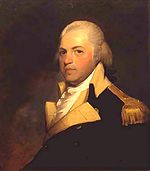Nathaniel Gist
Nathaniel Gist | |
|---|---|
| Born | 15 October 1733 Braddock's Expedition (1755) (1780)Forbes Expedition (1758) Cherokee War (1760) Battle of Paulus Hook (1779) Siege of Charleston |
Nathaniel Gist (15 October 1733 – 1812) was born in Maryland and fought during the
French and Indian War
Born on 15 October 1733 in
In 1757, Gist received promotion to captain and was given responsibility for 200 Cherokees living in Virginia. He was credited with leading these native peoples as an auxiliary force during the successful Forbes Expedition of 1758.[4] In 1760, Gist accompanied Daniel Boone and other hunters on a trek to Abingdon, Virginia, then called Wolf Hill. The two then split up, with Boone going on to Long Island and Gist traveling to Cumberland Gap.[5] He was said to have sired Sequoyah in 1760 or 1761, but this is unlikely because the Anglo-Cherokee War was raging and Gist was serving in Adam Stephen's colonial Virginia regiment against the Cherokees. This unit advanced as far as Long Island before peace was made between the two sides.[6]
American Revolutionary War

Samuel C. Williams believed that Gist fathered Sequoyah around 1775 by his mother Wurteh Watts.[7] Of a prominent clan, she was related to Old Tassel. Williams dismissed the story that Sequoyah's father was an itinerant German peddler by the name of Guess. He noted that Sequoyah went by George Guess, Guest, and Gist, and that he finished the Cherokee alphabet in 1821 when he was about 40. This was much too young for a man born in 1761. Williams noted that a letter showed that in 1828, Sequoyah visited Gist relatives in Kentucky and was acknowledged as a family member.[7]
The year 1775 found Gist living with the Overhill Cherokees. After a trip to

In 1776, Virginia sent an expedition under
Washington appointed Gist
On 22 April 1779, Gist's Regiment absorbed
Gist received 7,000 acres in Kentucky for his services in the war. He moved there in 1793 and built an estate called Canewood. At that time he was described as six feet tall and "stout-framed", with a dark complexion. Williams believed that he died around the end of the War of 1812.[14] Historian Francis B. Heitman asserted that Gist died in 1796.[15]
Family
Nathaniel had two brothers, Richard Gist, who was born on 2 September 1729 and died at the
Notes
Footnotes
- ^ This suggests that Gist's regiment either formed part of the attacking column or part of Lord Stirling's relief force. But this is not stated by Boatner.
Citations
- ^ a b c Williams (1937), 3
- ^ Williams (1937), 3-5
- ^ Williams (1937), 6
- ^ Williams (1937), 7
- ^ Williams (1937), 8
- ^ Williams (1937), 9
- ^ a b Williams (1937), 10-11
- ^ Williams (1937), 12-14
- ^ Williams (1937), 14-15
- ^ a b c d Boatner (1994), 436
- ^ Wright (1989), 101
- ^ a b c Wright (1989), 321
- ^ Boatner (1994), 209
- ^ Williams (1937), 18-19
- ^ a b Heitman (1914), 249
- ^ a b Williams, 19
References
- ISBN 0-8117-0578-1.
- Heitman, Francis Bernard (1914). Historical Register of Officers of the Continental Army during the War of the Revolution. Washington, D.C.: Rare Book Shop Publishing Company.
- Williams, Samuel C. (1937), Chronicles of Oklahoma, The Father of Sequoyah: Nathaniel Gist, archived from the original on 25 May 2013, retrieved 10 February 2012
- Wright, Robert K. Jr. (1989). The Continental Army. Washington, D.C.: US Army Center of Military History. CMH Pub 60-4.
